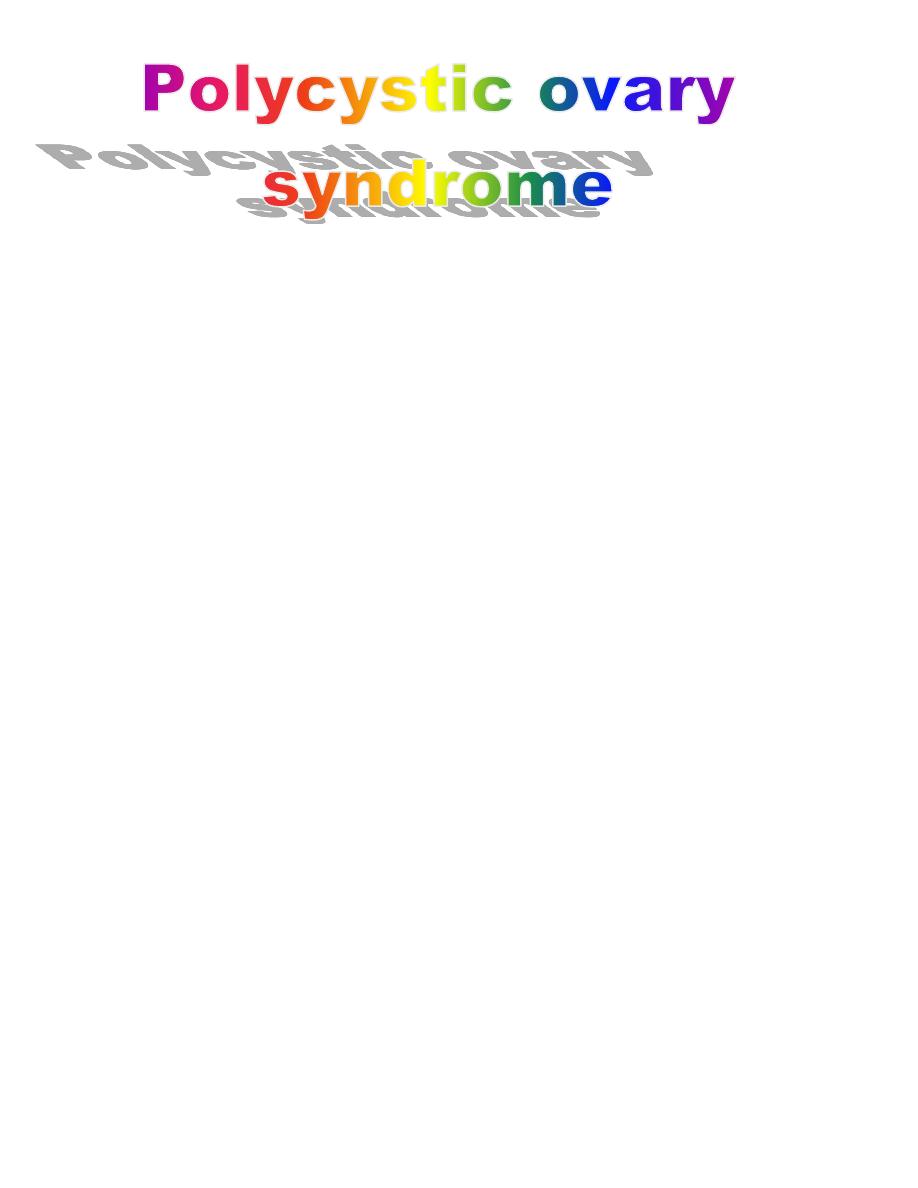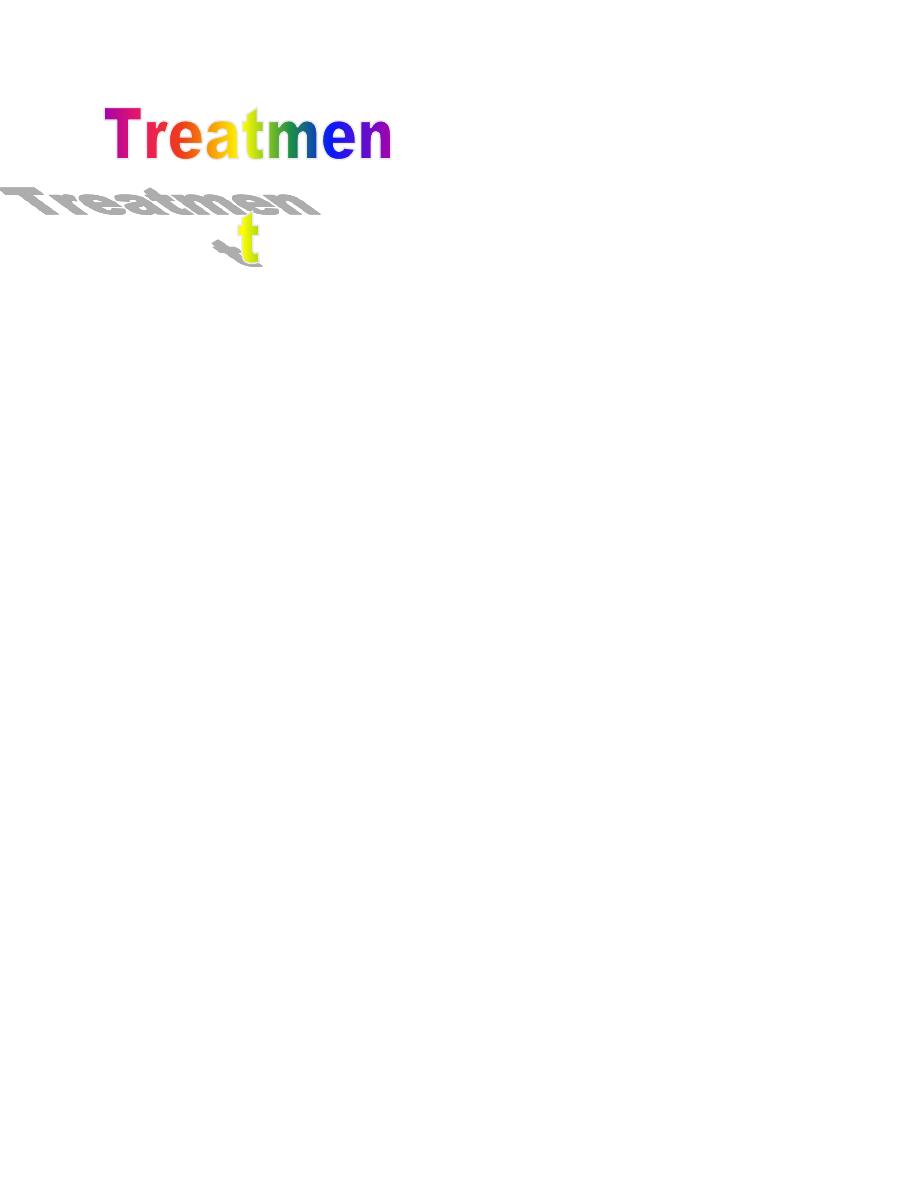
1
Dr. Alaa AL-Naser
1.revise your knowledge of the normal physiology of ovulation.
2.define PCOS precisely, importance of lifestyle, environmental factors on progress
of PCOS.
3.understand how androgens are formed in female and their mode of action.
4.classical US appearance of PCOS
5. know different types of drugs used in Mx of PCOS and indications for use&
mode of action.
(PCOS), a heterogeneous disorder of unclear etiology, is an important cause of both menstrual
irregularity and androgen excess in women. When fully expressed, the manifestations include
ovulatory dysfunction, androgen excess, polycystic ovaries, and obesity. It is recognized as one
of the most common endocrine/metabolic disorders of women. This syndrome was first
described by Stein and Leventhal in 1935.
DEFINITION
— is defined by the presence of two out of the following three criteria: (
Rotterdam)2003
(i)Oligo-and / or anovulation
(ii)hyperandrogenism(clinical or biochemical)
(iii)polycystic ovaries(with exclusion of other cause of androgen excess and menstrual cycle
irregularities)
NIH(1990) criteria include both of the following:
1. Oligo-ovulation
2. Hyperandroginism and or hyperandrogenemia after exclusion of other causes.

2
EPIDEMIOLOGY
— Polycystic ovary syndrome is recognized as one of the most common
endocrine/metabolic disorders of women. Its prevalence depends in part upon the diagnostic
criteria used to define the disorder, affecting between 6.5 and 8 percent of women overall.
High-risk group
— A number of conditions are associated with an increased prevalence of
PCOS:
1. Women with oligoovulatory infertility
2. Obesity and/or insulin resistance, although the impact of obesity appears to be
relatively modest.
3. Type 1, type 2, or gestational diabetes mellitus.
4. A history of premature adrenarche.
5. First-degree relatives with PCOS.
6. The prevalence of PCOS also appears to be somewhat higher among Mexican-American
than Caucasian or African-American women.
7. Women using antiepileptic drugs — valproic acid is associated with the development of
features of PCOS, others suggest that the association is between epilepsy and PCOS,
independent of antiepileptic medication use.
PATHOGENESIS
Polycystic ovary syndrome is a functional disorder of unclear etiology. Prior to the description
of Stein and Leventhal, the presence of sclerocystic ovaries was felt to be due to a number of
disparate etiologies. In 1910, Fogue and Massabuau described three potential mechanisms:
inflammation, congestion, and dystrophy. The inflammation theory proposed that the
microcystic ovary was the result of infection either of internal or external provenance. The
congestion theory suggested that the lesion was the result of pressure, partial torsion, or
other interruption in circulatory flow to the ovary. Finally, the dystrophy theory proposed that
the abnormalities were caused by modifications or abnormalities in the nutrition of the ovary.
Others suggested that the development of polycystic ovaries was due to the morphological
changes observed in the ovaries, including a thickened tunica albuginea which impeded
normal ovulation; however, these anatomic changes appear to primarily reflect the endocrine
milieu, and effective ovulation is achievable by modulating the endocrine environment with
clomiphene, gonadotropins, or insulin sensitizers.

3
Some investigators proposed an adrenal etiology for PCOS, based upon observations in
patients with congenital adrenal hyperplasia or adrenal neoplasms, and the response of the
patients to cortisone therapy.
PCOS is now thought to be a complex genetic trait, similar to cardiovascular disease, type 2
diabetes mellitus, and the metabolic syndrome, where multiple genetic variants and
environmental factors interact to foster the development of the disorder.
Genetic studies — Many candidate genes have demonstrated some evidence of linkage or
association with PCOS, it may be familial( inherited).
Pathophysiology of pcos
Gonadotropin secretion and action
— anovulation in PCOS is k.k by inappropriate
gonadotropin secretion, alteration in GnRH pusitality lead to preferential production of LH
compared with FSH , so increase LH/FSH ratio, that affect ovarian theca cell lead to increase
androgen production.
while the paucity of FSH prevent adequate stimulation of aromatase
activity with in granulosa cell thereby decrease conversion androgen to potent estrogen
estradiol.
Insulin secretion and action
— insulin resistance, and the development of compensatory
hyperinsulinemia, is a frequent finding in PCOS. the mechanism of decrease insulin sensetivity
appears to be due to a postbinding abnormality in insulin receptor-mediated signal
transduction.Insulin is apotent stimulant for androgen secretion by the ovary, and suppress
liver production of the main carrier protein(SHBG).
Weight and energy regulation
— The presence of obesity worsens insulin resistance, the
degree of hyperinsulinemia, the severity of ovulatory and menstrual dysfunction, and
pregnancy outcome in PCOS, and is associated with an increasing prevalence of metabolic
syndrome, glucose intolerance, cardiovascular risk factors, and sleep apnea.
Androgen biosynthesis and action
— a feature central to PCOS is hyperandrogenism, which
is primarily of ovarian origin, although the adrenal cortex often hypersecretes androgens, as
well. Although hyperinsulinism is associated with hyperandrogenism in PCOS, insulin
resistance alone is not sufficient for the development of PCOS, suggesting that an underlying
(genetic) predisposition to hyperandrogenism must also be present.both insulin and LH
stimulate ovarian theca cell androgen production specialy (testosteron, and androstendione
70-80%) and( DHEAS in 25-65%), in turn androsendione lead to increase level of esterone

4
through periphral conversion of androgen to estrogen. esterone have feed back effect on
anterior pitutary gland lead to increased level of prolactin hormon.
Sex hormone binding globulin
- women with PCOS display decrease level of SHBG which is
suppressed by insulin and androgen, corticoid, progestin, and growth hormon, thus less
circulating androgen is bound, and available to end organ, so total testosterone is normal level
and patient clinically hyperandrognic.
Anovulation
-hyper secretion of LH lead to anovulation, insulin resistance, and large no. of
antral follicle, cause anovulation and low progestin level
Environmental factors
— The most clearly defined environmental factor likely affecting the
development of PCOS is diet and its association with obesity. Nonetheless, despite wide
variations in the populational prevalence of obesity and type of diet, the populational
prevalence of PCOS appears to remain similar. Other potential factors may include as yet
undetermined androgen-mimicking environmental toxins.
CLINICAL MANIFESTATIONS
— It is important to appreciate that PCOS is a syndrome, reflecting
multiple potential etiologies and variable clinical presentations. The key features of PCOS are
oligo- or anovulation and hyperandrogenism. Women with PCOS may also have polycystic
ovaries on pelvic ultrasonography, infertility due to oligoovulation, obesity, and insulin
resistance.
1. Menstrual dysfunction
The menstrual dysfunction in PCOS is characterized by oligo- or amenorrhea, and therefore,
infrequent or absent ovulation. The menstrual disturbances in PCOS classically have a
peripubertal onset. Affected women may have a normal or slightly delayed menarche followed
by irregular cycles. Other women may apparently have regular cycles at first and subsequently
develop menstrual irregularity in association with weight gain.(fewer than 8 cycle per year).
2. Hyperandrogenism
Hyperandrogenism is the second defining characteristic of PCOS. This is manifested clinically
by hirsutism, acne, and male pattern balding. In rare instances, increased muscle mass,
deepening of the voice, or clitoromegaly may occur, but these findings are suggestive of other
causes of virilization, such as a neoplasm of the ovary or adrenal gland.
3. Other endocrine dysfunction

5
a. Insulin resistance
lean and obese women with PCOS have increase rates of insulin resistance
and type 2 D.M.
b. acanthosis nigricans
this skin condition is k.k by thickened, gray-brown velvety plaques seen
in the area of flexure like back of the neck, axilla, the crease beneath the breast, waist,and
groin.
It is k.k feature of insulin resistance (hyperinsulinaemia) that stimulate keratinocyte and
dermal fibrocyte lead to such skin changes. It may be present in genetic syndrome and some
gastrointestinal malignancy like adenocarcinoma of stomach and pancreas.
c. impaired GTT and type 2 D.M
incidence in PCOS is 30%and7% respectively.
d. dyslipidemia
: the classic atherogenic lipoprotein profile seen in PCOS is k.k by elevated LDL,
TG level and total cholesterol-HDL, and by depressed HDL level.
These changes increase risk of cardiovascular disease.
e. obesity
: women with PCOS are more likely to be obese (increase BMI and waist:hip ratio),
this ratio reflect android or central pattern obesity which indepandant for cardiovascular
disease.
4. Obstructive sleep apnea
It is more common in PCOS women and is likely related to central obesity and insulin
resistance(30-40 fold higher in PCOS)
5. Metabolic syndrome and cardiovascular disease
This syndrome is k.k by insulin resistance. Obesity, atherogencdyslipidemia and hypertention.
It associated with increase risk of CV disease, the metabolic syndrome is 40% prevelance
among PCOS women.
Increase CVD, myocardial infarction, left ventricular dysfunction and external carotid artery
stiffness, atherosclerosis.
6. Endometrial hyperplasia and cancer
The reduction in ovulatory events in PCOS leads to deficient progesterone secretion. Thus,
women with PCOS may have constant mitogenic stimulation of the endometrium (chronic
estrogen stimulation, no progesterone for differentiation) leading to intermittent
breakthrough bleeding (frequent or unusually heavy menstrual bleeding typically associated

6
with anovulation), so three fold increased risk of endometrial cancer in PCOS.
7. Anovulatory infertility
Women with PCOS have infrequent ovulation, and therefore take longer to conceive(80-90%).
Many, if not most women who have PCOS and oligoovulation and desire fertility eventually
undergo ovulation induction therapies. Women who have PCOS may have other reasons for
infertility as well, since they have, in comparison to women with hypothalamic amenorrhea, a
reduced rate of conception relative to the rate of ovulation after therapy with clomiphene
citrate.
8. Pregnancy loss
increased rate of early pregnancy loss in PCOS(30-50%), the mechanism of which is poorly
understood, LH hypersecretion, insulin resistance may be a cause of miscairge, usage of
metformine in women while conception reduce miscarriage rate.
9. Complication in pregnancy
PCOS have 2-3 fold higher risk of gestational D.M, pregnancy-induced hypertention, preterm
birth, prinatal mortality, unrelated multifetal gestation(ovulation induction, IVF), neonatal and
maternal complication.
10. Mood disorders
There is evidence that PCOS is associated with mood disorders (depression and anxiety),
impaired quality of life, and eating disorders (binge eating), even when compared to women
with the same BMI.
11. Breast cancer
Obesity, hyperandroginism and infertility occur frequently in PCOS and associated with
development of ovarian cancer.
12. Ovarian cancer
PCOS may be associated with ovarian cancer due to ovulation induction, infertility, oligo-
ovulation may be protective factors against ovarian cancer.

7
PCOS is often referred to as a diagnosis of exclusion:
DIFFERENTIAL DIAGNOSIS
The diagnosis of PCOS is viewed by some as one of exclusion. Other causes of hyperandrogenism
include hyperprolactinemia, drugs (danazol and androgenic progestins), nonclassic congenital
adrenal hyperplasia, ovarian and adrenal tumors, and Cushing's syndrome.
1. TSH and prolactin and B-hCG
Thyroid disease may frequently lead to menstrual dysfunction to that of PCOS, serum TSH level
typically measured during evaluation, hyperprolactinaemia is a well-known cause of menstrual
irregularities and occasionally amenorrhea, elevated prolactin levels lead to anovulation
through inhibition of GnRH pulsatile from the hypothalamus.
2. Testosterone
Tumor of the ovary or adrenal are a rare but serious cause of androgen excess. A variety of
ovarian neoplasm(benign and malignancy), may produce testosterone and lead to virilization.
Women with abrupt onset, with several months, sudden worsening of virilizing sign(deeping of
the voice, frontal balding, sever acne or hirsutism, increase muscle mass and clitoromegaly.
Acoordingly serum testosterone levels may be used to exclude to exclude these tumors.
3. Dehydroepiandrosterone sulphate
DHEAS is produced exclusively by the adrenal gland, serum above 700mg/dl, highly suggestive
for the presence of adrenal neoplasm. Adrenal imaging with CT or MRI is indicated for any
patient with increase this level.
4. Gonadotrophins
During evaluation of amenorrhea, FSH and LH are typically measured to exclude premature
ovarian failure and hypogonadotropic hypogondism. In PCOS LH tow fold higher than FSH
level.
5. 17-hydroxyprogesterone

8
Congenital adrenal hyperplasia(21-hydroxylase or 11-hydroxylase deficiency), symptom varied
neonatal ambiguous genitalia,hypotention or late onset CAH lead to virilization,accumulation
of 17-hydroxy progesterone, serum value are drawn in morning fasting patient,≥ 200ng/dl,
should perform ACTH stimulation test(synthetic ACTH 250µg iv and serum 17-HP measured
after 1 hr. if more than 1000ng/dl is dx. Of late onset of CAH.
6. Cortisol
Cushing syndrome result from prolonged exposure to elevated level of endogenous or
exogenous glucocorticoid, PCOS may present with symptom mimic cushing syndrome, so
analysis of 24 hr. urine collection of free cortisol, dexamethasone suppression test.
7. Measurenets of insulin resistance and dyslipidemia
The gold standared of insulin resistance for evaluating insulin resistance has been the
1. hyperinsulinemic euglycemic clamp(iv GTT)
2. 2-hr OGTT
3.fasting insulin level
4.insulin sensitivity check 5.calculation of serum
glucose:insulin ratio
8. Endometrial biobsy
Is recommended in women older than 35 with abnormal uterine bleeding or younger women
with anovulatory bleeding refractory to hormonal medication.
9. Sonography
Histologically a polycystic ovary displays increases in volume, number of hilar cell nests.
Sonographic criteria of PCOS include ≥ small cysts(2-9mm indiameter) peripherally located or
an increased ovarian volume(> 10 ml )or both. Often there is increased amount of stroma
relative to the number of follicles, only one ovary with these finding is sufficient to define
PCOS.
Pcos should be diferrantiated from multicystic ovary which is normal size contains or more
follicles without peripheral displacement and lacks an increase in central stromal volume.

9
The choice of treatment for each symptom of PCOS
depend on a woman goal and the severity of endocrine dysfunction.
I-
Observation
Women with PCOS who have fairly regular cycle intervals(8-12menses per year) and mild
hyperandogenism may choose no treatment, gust periodic screening for dyslipidemia and
D.M.
II-
Weight loss
In many overweight and obese women with PCOS, weight loss alone is often associated with
a reduction in serum testosterone concentration, resumption of ovulation, and pregnancy(5%
reduction in body wt. can result in restoration of ovulatory cycle) diet rich in protein and fat
lower the insulin secretion, well balanced hypocholaric diet offers the most benefit in treating
obese women in PCOS
Low-carbohydrate diets have become very popular for women with PCOS, based upon the
notion that less carbohydrate leads to less hyperinsulinemia, and therefore less insulin
resistance. were equally effective for weight loss, improvements in menstrual Bariatric
surgery is another strategy for weight loss in PCOS.
III-
Excersise
Excersise is beneficial effect in treating patient with type 2DM, any woman at risk for DM ask
to lose 7% from her wt. and excersise for 150 minute each week.
IV-
Oligo-ovulation and unovulation
Typically have fewer than 8 cycle per year, skip mense for several months, amenorrhea, flow
scanty or long heavy:

10
COCCP
: a first line treatment of menstrual irregularities is coccp which produce regular
menstrual cycle, reduce androgen increase SHBG, and progestin component protect
endometrium. If amenorrhea more than 4 weeks B-hCG should done, with drawl bleeding
prior to pills with 10 mg medroxy progesterone acetate for ten days.
Cyclic progestin
: in women who are not candidate for OCCP with drawl bleeding every 1-3
months(5-10 mg MPA for 12 days every month).
Insulin sensitizing agents
: Metformin, a drug whose major effect is to increase insulin action
and lower serum insulin concentrations, may promote ovulation either alone or in
combination with clomiphene.
Thiazolidinediones — Thiazolidinedione therapy may also be effective for induction of
ovulation.
It account that 40% of women with PCOS ovulate and can achieve pregnancy with metformin
alone.
VI- hirsutism
Our approach to the management of hirsutism is consistent an estrogen-progestin
contraceptive as first-line pharmacologic therapy for most women. An antiandrogen is then
added after six months if the cosmetic response is suboptimal
.
For women with hirsutism and contraindications to oral contraceptives, we sometimes use
spironolactone alone, but an alternative form of contraception is essential, because if
pregnancy occurs, an antiandrogen such as spironolactone could prevent development of
normal external genitalia in a male fetus. If spironolactone alone is used, endometrial
protection is also needed
.
We typically start with an oral contraceptive preparation containing 30 to 35 mcg of ethinyl
estradiol combined with a progestin with minimal androgenicity (such as norethindrone,
norgestimate, desogestrel, or drospirenone). After six months, if the patient is not satisfied
with the clinical response, we typically add spironolactone 50 to 100 mg twice daily; this dose
can then be reduced over time as needed. Other antiandrogens that are effective include
finasteride and cyproterone acetate
.
Oral contraceptives and antiandrogen therapy may also reduce acne, but an occasional
woman needs antibiotic or other therapy
.

11
Hirsutism can also be treated by removal of hair by mechanical means such as shaving, waxing,
depilatories, electrolysis or laser treatment. In addition, Vaniqa (eflornithine hydrochloride
cream 13.9 percent) is a topical drug that inhibits hair growth. It is not a depilatory, and must
be used indefinitely to prevent regrowth
.
Laparoscopic surgery
— In the past, wedge resection of the ovaries was a standard treatment
for infertility in women with PCOS. However, this approach has been abandoned, both because
of the efficacy of clomiphene, and because of the high incidence of pelvic adhesions seen with
wedge resection. A substitute for wedge resection, laparoscopic ovarian laser electro cautery,
may be effective in some women with PCOS. However, given the other pharmacologic options
for ovulation induction, surgery is not often indicated.
Ovulation induction
with clomiphene citrate, gonadotropins, GnRH analogue, metformine in
cases of infertility cause by PCOS.
Treatment of acne
with topical and systemic AB., topical benzoyl peroxide, topical retinoid,
isotretinoin.
Acanthosis nigricans
treated with insulin sensitizers, topical AB., topical and systemic retinoid,
keratolytics, topical corticosteroid.
